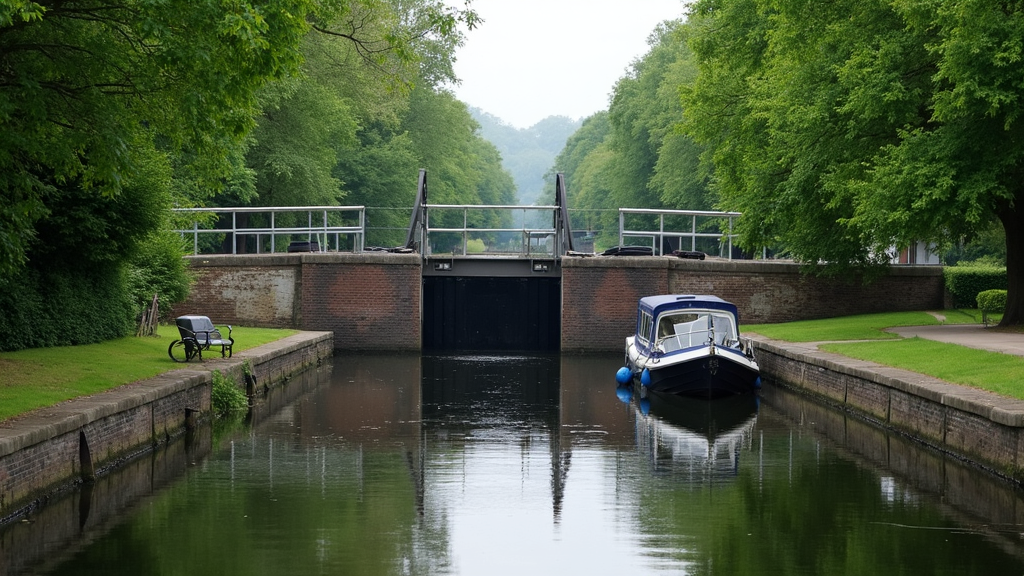Navigating Locks: A Step-by-Step Guide
Learning to find your way around a lock on a canal or river is a rite of passage for anyone interested in boating. These clever water elevators help vessels move smoothly between different water levels, and knowing the right steps can make your adventure much less stressful. Here’s a step-by-step guide for handling locks with confidence, whether you’re steering your own small boat or tagging along on a weekend cruise.

Understanding Canal and River Locks
Locks have played a big part in water navigation for centuries, helping boats skip up and down steps in the waterway. The basic idea hasn’t changed much. The lock chamber fills up or empties water to let your boat travel from one level to another. It can look complicated at first, but the process is straightforward when you know the order.
Most locks you’ll face are either manually operated or automated. Manual locks call for a bit of muscle as you wind paddles and open heavy gates by hand. Automated locks rely on buttons or levers. In both cases, the routine stays about the same, and a bit of practice can go a long way in building your confidence around these watery gates. Some historic locks still have original parts; look out for information plaques along the towpath for interesting lock history as you cruise.
First Steps Before Entering the Lock
Preparation helps everything run smoothly. Here’s what to do before getting close to a lock:
- Slow Down and Observe: Approach the lock at a slow pace so you have plenty of time to react to what’s ahead of you.
- Check Signals: Look for traffic lights, signals, or operator instructions. Some locks run on a ‘first come, first served’ basis, while others use traffic control systems.
- Gather Crew: If there’s anyone with you, have everyone set with jobs. Someone should handle the lines, another person might work the gates or paddles, and a good lookout is always helpful.
- Put on Life Jackets: Safety gear should be worn by everyone on board, especially for first-timers or children.
Locks can get busy, especially on popular routes in summer, so being organized from the start helps avoid unnecessary stress. If you’re new and solo, don’t worry—most locks are built so you can handle them alone if you take your time.
Going Through the Lock: A Step-by-Step Process
Here’s how to move your boat through a lock. Every lock is a little different, but most will follow these steps.
- Wait Your Turn: Keep a safe distance from the boat ahead and wait until the lock gates are open for you to enter. Make sure nobody is coming out before you head in.
- Enter Slowly: Motor or paddle gently into the lock chamber. Tie up securely to the bollards (the short posts on the lock edge) using your bow and stern ropes. Fenders—those big bumpers—protect your boat from scraping against the lock walls.
- Close the Gates: If you’re operating the lock yourself, walk to the gates at the end you entered from and close them fully behind your boat.
- Let Water In or Out: Use the winding gear or buttons to open the paddles (the valves that allow water to flow in or drain out). Open them slowly to avoid big surges. Fast-moving water can shake the boat around quite a bit.
- Adjust Your Lines: As the water rises or drops, keep adjusting your ropes so the boat stays in the middle and doesn’t get caught on the sides.
- Open the Next Gates: Once the water level inside the lock matches the outside level on the exit side, open the gates.
- Exit Smoothly: Loosen your ropes, steer out gently, and wave a thank you to anyone waiting or helping out.
Most people quickly get the hang of these steps after a few tries. If you’re unsure, watching other boaters can be really helpful. Don’t hesitate to ask more experienced crews for help or advice. They’re usually happy to lend a hand.
Common Challenges and How to Tackle Them
Moving through locks isn’t always totally smooth. Here are some things you might come across and how to handle them:
- Strong Currents: Water inside the lock can rush in or out quickly. Go slow, keep your line handlers alert, and open paddles gradually.
- Boat Drift: Some boats, especially small or light ones, tend to drift in the chamber. Keep bow and stern ropes in hand and have someone hold them snug but not too tight.
- Slick, Wet Surfaces: Lock walls and platforms are often damp or mossy. Watch your step and wear shoes with good grip.
- Broken Equipment: If winding gear or paddles are stiff or jammed, don’t force them. A friendly call to the local canal authority usually gets you help fast.
It’s normal to feel a bit of nervous energy the first few times you go through a lock, but most issues can be solved with patience and attention.
Staying Safe Around Locks
Always be extra careful near lock edges. Wet stone is slippery, and there are big drops in the chamber. Along with life jackets, keep arms and legs inside the boat and never try to jump from the boat to the lock edge while moving. Things can get hectic if someone tries to rush. Make sure children are seated and supervised during the locking process.
Teamwork and Communication
If you have crew, clearly stating what everyone should do makes a huge difference. Talking through the steps before arriving helps so nobody is surprised. If you’re on your own, take each stage slowly. There’s usually no need to hurry. Lock-tenders or nearby crews often offer help if you look like you could use it. Good communication keeps everyone relaxed and safe.
Helpful Tools for Easy Lock Navigation
Packing the following items saves a lot of headaches:
- Lock Key or Windlass: Most manual locks use a special handle for winding up paddles. Always keep one handy.
- Strong Ropes and Fenders: Reliable ropes help secure your boat, and sturdy fenders save your paint job from scratches.
- Boat Hook: Great for pushing off lock walls or snagging ropes out of the water.
- Gloves: Leather or rubber gloves save your hands when handling wet, gritty ropes or cranky iron windlasses.
Some experienced boaters also bring a small first aid kit in case someone gets a scrape or bump during the process. The right gear makes the day run much smoother, especially for beginners. For extra comfort, bring a spare set of dry clothes—it’s easy to get splashed!
Real-Life Example: My First Time Navigating a Lock
The first lock I handled was along a narrow canal just outside Oxford. I was nervous at first, but the boater in front of me offered some quick advice about winding paddles slowly and keeping an eye on both ends of my boat. Everything went smoothly with some patience and attention. By my third lock I felt way more relaxed. Most challenges seemed big before I tried them, but they faded fast as my confidence grew. The social aspect of locks also surprised me. Chatting with fellow boaters, swapping tips, and sharing a laugh while waiting turned locking into one of the highlights of my canal trips. It gave me a new appreciation for both the history and community spirit that canals foster.
Top Tips for Smooth Lock Navigation
After a few seasons cruising canals, here are a few things I wish I’d known at the start:
- Pace yourself and avoid rushing; locks are often the social hubs of the canal and can be enjoyable if you take your time.
- Be polite and patient with other crews; sharing locks is common, and a good attitude makes everyone’s adventure better.
- Keep an eye out for wildlife, especially ducks and swans that love hanging around locks. Sometimes, they float into the lock with you!
- If anything feels confusing, ask another boater or a lock-keeper. Most people love to share their knowledge and stories. You may even track down some local canal legends in the process.
- Keep a logbook or jot notes about quirky locks you meet along your route. Some locks are narrower, deeper, or have unusual features. These details can help when you return or plan your next outing.
Frequently Asked Questions
Here are some of the most common questions I hear from lock first-timers:
Question: How long does it usually take to get through a lock?
Answer: Most locks take between 15-30 minutes, depending on size, traffic, and whether you’re sharing with other boats.
Question: Does every boat need to use ropes inside the lock?
Answer: Absolutely. Ropes keep you steady and stop you from bumping into the edges or other boats.
Question: What should I do if I get stuck inside a lock?
Answer: Stay calm, tie your boat securely, and call for help if you need it. There are emergency ladders and call points in most modern locks, and canal staff are usually quick to help boaters out.
Question: Is there a best time of day to go through locks?
Answer: Early mornings or late afternoons are usually quieter than midday, which can help beginners move through locks with less stress. However, the lively midday crowd is perfect for making new friends and learning tips from other boaters.
Why Learning Lock Navigation Matters
Developing your skills around locks adds a lot to your boating adventure. Confidently handling locks means you can travel new routes, reach more interesting places, and explore quieter stretches of river or canal that less experienced boaters might avoid. Knowing the proper way also keeps everyone on board safe and helps preserve the historic waterways for others to enjoy.
The next time you approach a lock, use these steps and tips to take things steady. With practice, navigating locks feels less like a challenge and more like a fun part of your adventure. Make the most of every locking stop to rest, chat, or soak in the beauty around you—you might just stumble upon a new favorite spot along the waterway!
